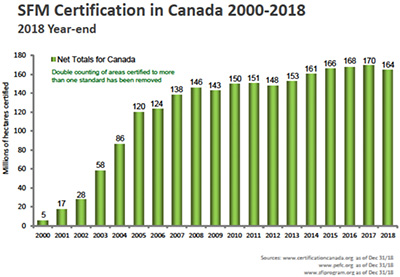Forest Certifications

Canada’s forests play an important role in carbon-emission removal. As trees grow, they absorb and store carbon dioxide (the emissions that contribute to global warming). When carbon dioxide is captured from the air and stored in trees, this natural way of storing carbon is known as a “carbon sink.”
Once a tree is harvested, it begins a second life as a forest-based product. Because wood products continue to store carbon emissions even after they’ve been manufactured, both the living trees and the forest products we create from them contribute to the world’s overall health — if the forest is sustainably managed.
This means that when forest resources are utilized strategically, carbon can continue to be stored in forest products for decades. For example: 2×4 dimensional lumber and mass timber are just two types of manufactured products that store carbon for the duration of their lives, so a combination of sustainable forest management and strategic use of forest products means ensures that global carbon emissions are stored for as long as possible.
- Forest-management certification is carried out by independent organizations whose job it is to assess forestry operations, and to certify them based on sustainable forest management standards. Held to these standards, Canada is home to the world’s largest area of third-party-certified forests. This credentialed certifications, when paired with the country’s strong forest-management governance, solidifies Canada’s reputation as the world’s top source of legally and sustainably produced forest products.
- To the end of 2019, across Canada, it has 168,002,236 ha certified forestland. 77% of Canada’s forest is certified.
- BC has 50,352,453 ha certified forestland (30% of Canadian total.). 83% of BC forests are certified.

